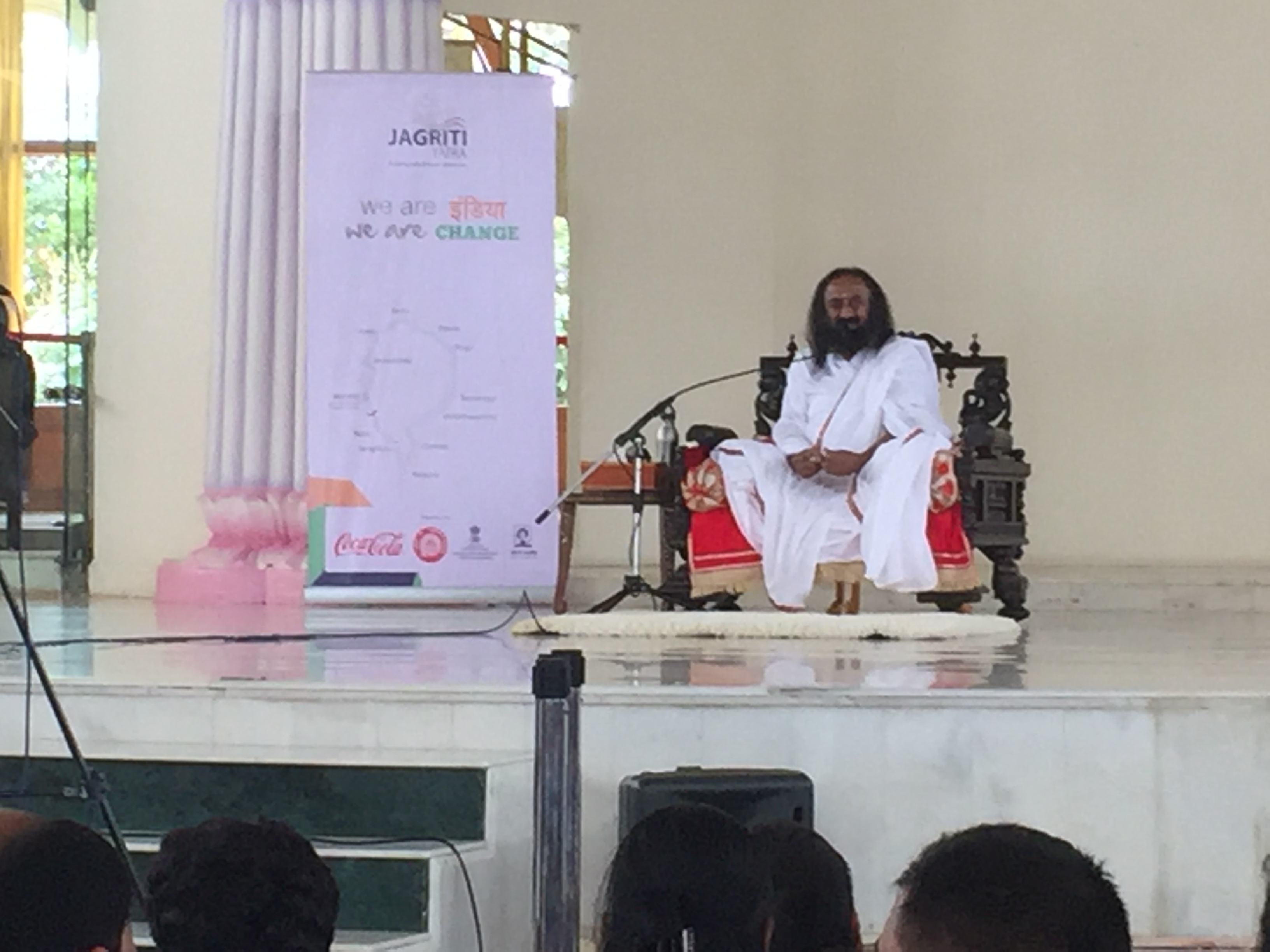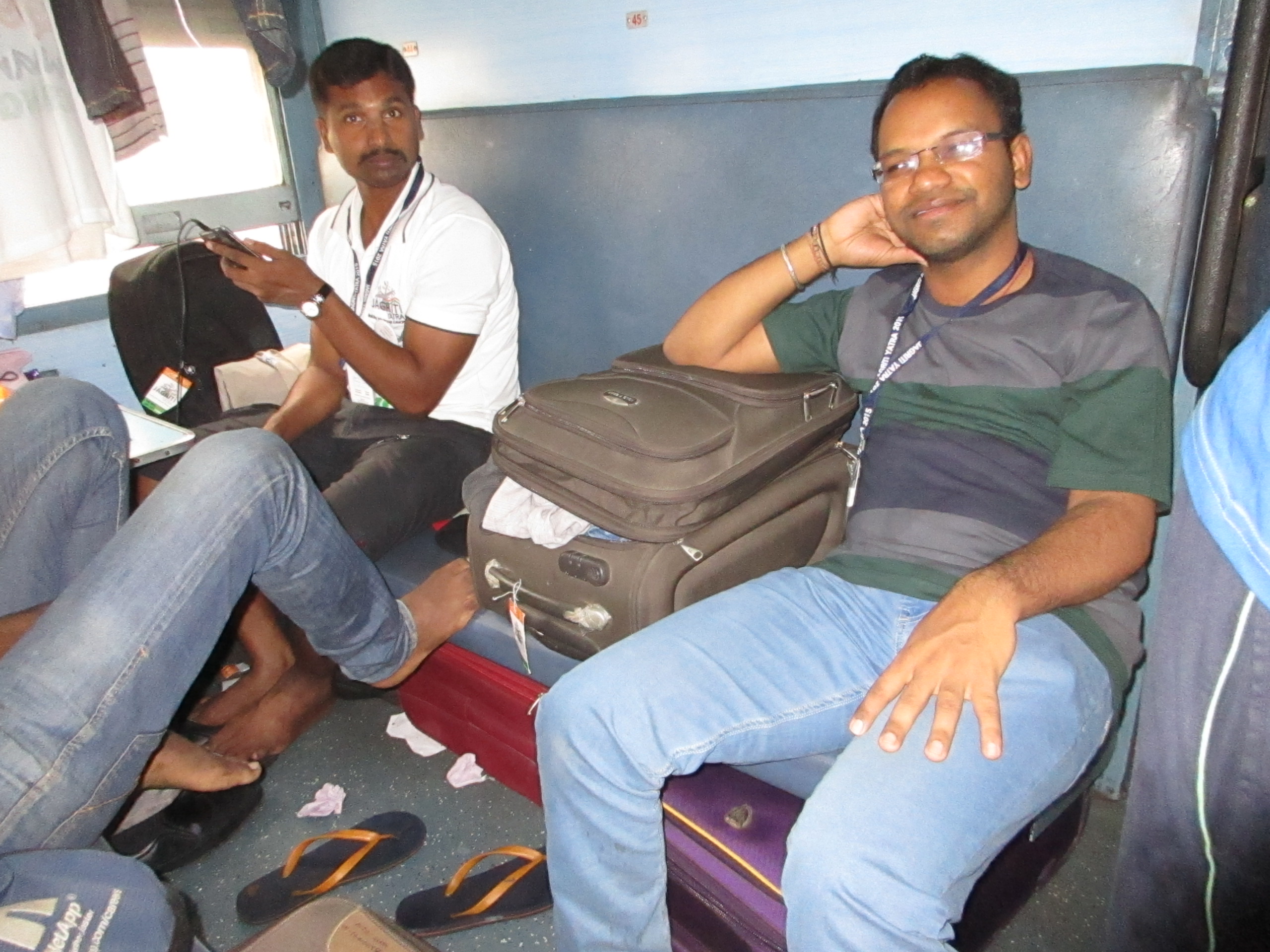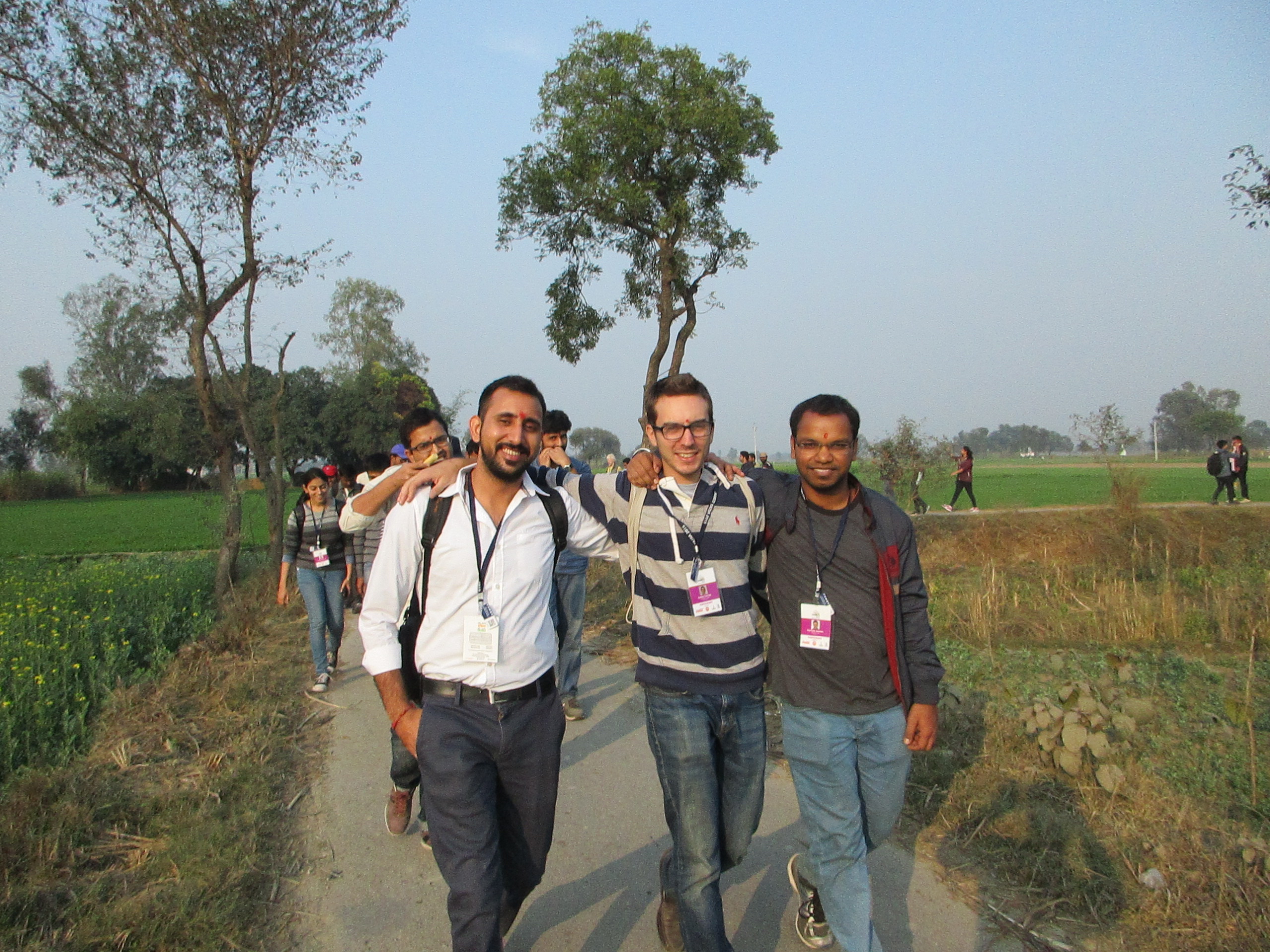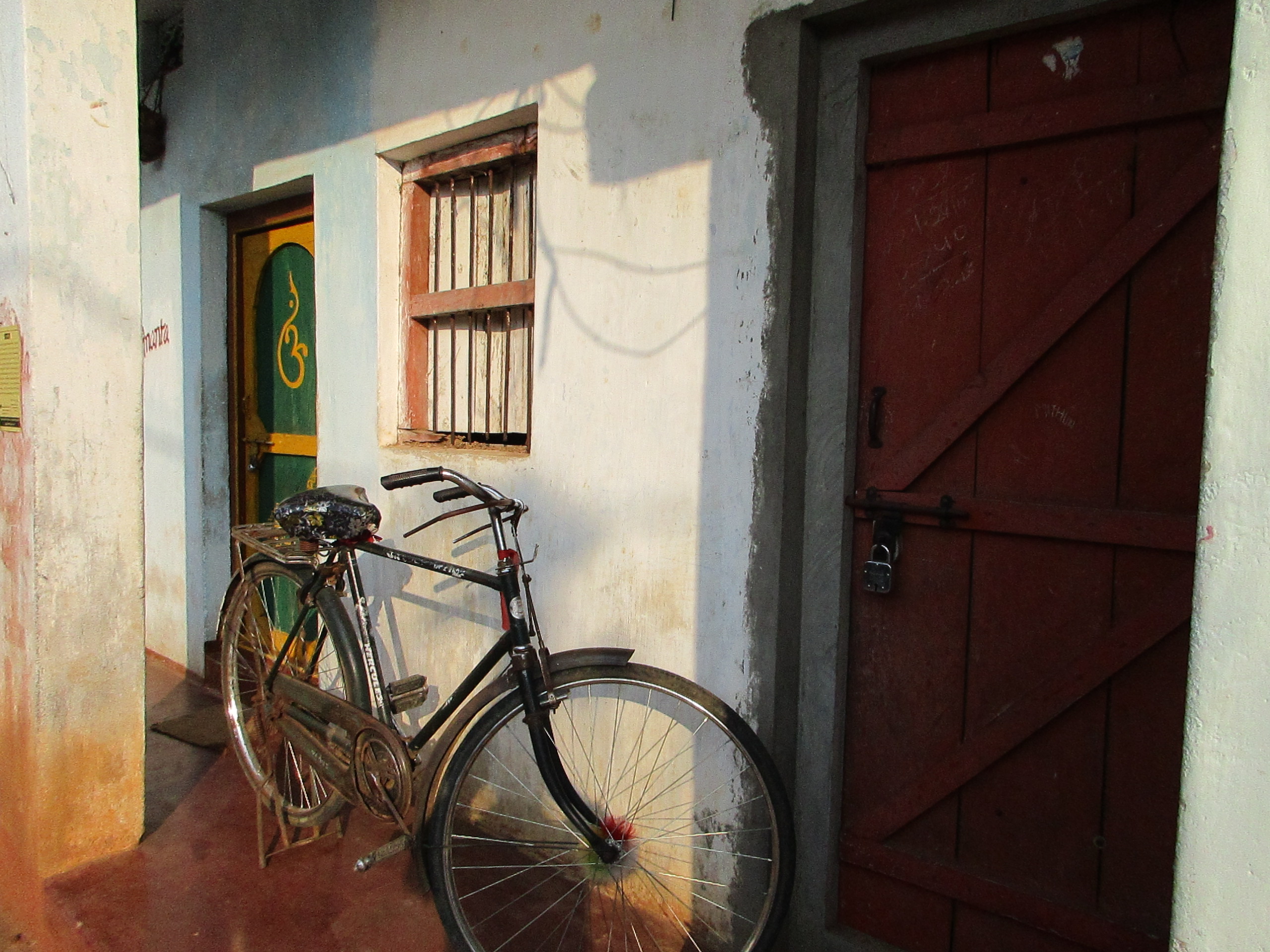I wrote daily journals on train. In order to give you the most authentic version of my experience, I’ve copied excerpts below. I’m using the exact words I used in my journal in order to give you the best understanding of what I was seeing, thinking, and feeling at that very moment.
Note: These are just excerpts – not full entries.
Day 1:
The most intelligent people I’ve ever met surround me. Everywhere I turn I meet accomplished entrepreneurs, CEOs, medical engineers, PhD’s, patented innovators, etc. People are from all over India – all over the world. And people work in different places as well: India, U.S., Canada, Qatar, Dubai, the list goes on. I feel welcome. I don’t feel intimated by the success around me, but rather motivated. Like I belong.
Everyone is on the same playing field on the train. No matter if you come from a village, or a penthouse in Mumbai, we are all together. We’re all stacked 3 beds high, living on-top of each other, sharing the same hole for a toilet. This trip is the ultimate steamroller for equality and balance. We are one.
Day 2:
Christmas. I woke up on a train. You can’t hide here. Teeth brushing, sleeping, hanging out – there is no solitude. My evening was packed full of political conversations about ISIS, capitalism, Donald Trump and electoral systems. I love it, but some people seem too excited, like this is the best thing they’ve ever done. We’ll see.
Day 3:
Euphoria is the word that comes to mind. I feel passion and thrill, a type that I haven’t experienced since my first weeks in India. As though something epic is in the air. Our Role Model visit today wasn’t overly interesting – we went to a school that uses traditional music to educate their students, and also runs off solar energy.
Discussed the topic of marriage in India today. Still baffles me how most of these people will have their marriages arraigned. It is one thing that education will never change in India – love marriages simply aren’t the norm. Development doesn’t have tentacles everywhere – some things remain untouched.
Took my first “shower” today. I used a plastic water bottle to bathe… it was awesome. Classic. Bunch of shirtless Indians belting out songs in Hindi. Didn’t matter they weren’t real showers or the water was freezing. All different walks of life. Reminded me of camp. The train looks like a cabin now with underwear and wet towels hanging from bungee cords. Nobody is comfortable, but at least we all have that in common.
Day 4:
Fatigued and tired, but battling through. It is not even 8am and I’ve already had three cups of chai and breakfast. We are almost in Bangalore. An absolute mess brushing teeth this morning. 30 people trying to use one sink at the same time. We ran out of water before it was my turn.
We saw Shiri Shri Ravishankar (famous guru) speak about the “Art of Living.” Wasn’t my favorite visit, but I learned a lot about the business side of spirituality. He has a huge following. An educational experience to say the least.
Day 5:
The landscape is changing and so am I. Train is home; outside is just a placeholder for the time we spend on this moving vehicle.
The south is beautiful – I am in Tamil Nadu. Went to Aravind Eye care today – they run a great healthcare model that has given 4.5 million cataract surgeries in the past 4 years. The volume of patients they are seeing is simply impressive.
Their model is based on the honor system: if you are poor, you get free eye care, if you can afford some care, you get a subsidy, and if you are rich, you pay for it. The system works really well here, but I don’t see it working in the West. In India, people know their “place” in society, but in Western culture, there is less differentiation between social class. Caste obviously plays a role in this contrast.
Day 6:
Hot, humid, and sweaty. We spent the evening singing Hindi songs – very fun.
Day 7:
We move north. It’s a picturesque morning as we move our way to Vishakhapatnam: a glowing green on all the trees, shining from the sun’s reflection. You can see the dew on the every leaf this morning as the train goes on. The sun rising beyond the hills – it will be another hot day today. I could repeat this every morning if I could. I’m yearning to run here.
Day 8:
New Years Eve. My first, and probably last, New Years I’ll ever spend on a train. I’ll never forget it. We went to Gram Vikas is Orissa – my favorite Role Model to date. They provide sanitation projects (mainly toilets) to rural villages. We visited one village where they work, which was a nice experience. Reminded me of Bagru. I was shocked how the Indians were acting – many had never been to a village in their lives. They were more foreign than I. I felt comfortable talking to the people in that village, like I was in Bagru again. Simple living.
After our visit we went to a school where there was a massive dance party. I danced a lot. Indians are always ready for a dance party.
When I got back to the train I started vomiting. A lot. My first time getting sick in nearly seven months in India – my body can’t handle the oil from this food. It is rejecting it completely.
Living in carriage house at Union last year was definitely training for tonight. Spending New Years on a train with 450 youngsters, dancing and blasting music, while I was throwing up – brought me back to living in an animal house. Living in such a dirty and constantly loud environment last year prepared me well for this. Sometimes no matter how loud and annoying people get, you just have to streamline their enjoyment to lift up your own spirit. Patience is key.
Day 9
I’ve gotten used to the movement of the train. It helps me sleep. My jeans are dirty. I mean fucking dirty. I don’t have another pair of pants.
We’ve spent all day on the train. I am sick. With each passing day, the cleanliness, hygiene, and overall health of the train is decreasing. There seems to be a filth piling up on every object in this train; it is an “inescapable modality” as James Joyce would say.
I am becoming more intolerant of those around me. Small things tick me off. I desperately miss the structured, organized, and healthy lifestyle of my summers at home. I need protein – I feel frail. The singing around is ceaseless – I must learn to adapt and embrace it. Everything is getting under my skin, but I’m trying to find the beautiful chaos of it all that I know exists. It has stolen my heart before, and it will again.
Day 10:
Rajgir. The birthplace of Jainism and Buddhism. The history is incredible. We visited Nalanda University – a progressive type of school with a liberal arts model. Made me realize how far ahead the U.S. is in terms of university education models.
Eager for challenge. I don’t know what 2016 will bring, but I am committed to running a 50-mile race this year.
Day 11:
Deoria. A long delay this morning, but we made it. Today is the final day of our Biz Gyan Tree competition (business plan). We are trying to implement business models in this impoverished agricultural district. In contrast to Rajasthan, this place is lush and green – similar to Bagru, but different in its aesthetics.
Got my appetite back for the first time in three days. We had two hours to prepare our business pitch. I was elected CEO. It was a fun time. We made a good pitch – I don’t think we will win, but we came together as a team and got creative. That’s what matters.
At night we had a fun dance party. Everyone here seems happy the business plan competition is over – a more relaxed vibe.
Day 12:
We slept on the dirt floor of a school in Deoria last night. It was freezing, but my sleeping bag and winter hat saved me. I feel even closer to these people after sleeping alongside them in such a rogue environment. We literally kept each other warm last night.
Full day today on the train. Crazy how 24 hours on a train doesn’t even seem long to me right now. Just another sunrise, sunset…the way it goes.
Day 13:
Delhi – the nation’s capitol. We went to Gandhiji’s grave to pay homage to his journey that we are replicating 100 years later. A true inspiration, though a stubborn man (in an admirable sense). Though, it did end up getting him assassinated by another Hindu. A strange, sad story. An MLK-like figure here. Father of this country.
We sat in an auditorium this afternoon. I slept a lot. Pure exhaustion. My body is struggling with this food.
At night we went to Goonj, a great Role Model visit. They make women’s sanitation pads out of recycled fabric and other goods. It was an honest and blunt portrayal of Indian poverty.
The Role Model was originally inspired after he worked in Delhi with a man who collects dead bodies off the street for 200 rupees each. Heart-wrenching speech.
Day 14:
Back in Rajasthan [the state where Bagru is]. I feel home. Woke up this morning with a head-cold, but a jump in my step. The feeling I get in this desert is indescribable. People even commented that they could tell I was near Bagru because of how good of a mood I was in.
We went to Barefoot College – my second visit there. They have “solar mommas” from villages all over the world who come here to do solar engineering. Many can’t read or write, but they can make a solar panel. I saw the same women from South Africa that I had met three months ago. They are still at Barefoot making solar panels, and are excited to go back and “light up their village” in South Africa. I would use the word “inspiring,” though I learned that word can be misleading…we’re often inspired by something but don’t actually follow up on that feeling.
Nice to finally meet Bunker Roy, the founder of Barefoot College. I asked him a question in the Q+A about replicability – impressed with his answer. His model works. The success speaks for itself.
Day 15:
Final day. Everyone is dressed in formal Indian clothes. Looking good despite our poor hygiene. I feel like I’ve pressed pause on my life and it’s about to resume. A bit daunting, while also exciting. Trains make you think; naturally, you just stare out the window and your mind wanders. What a genius journey this has been.
Day 16:
Ready to get off the train – we’ve been delayed nearly 6 hours getting into Mumbai. Everyone is sick, but we’re still writing goodbye letters and diary entries. We’ve been transformed. A lifelong network. Lifelong friends. Onto the next one.




















































